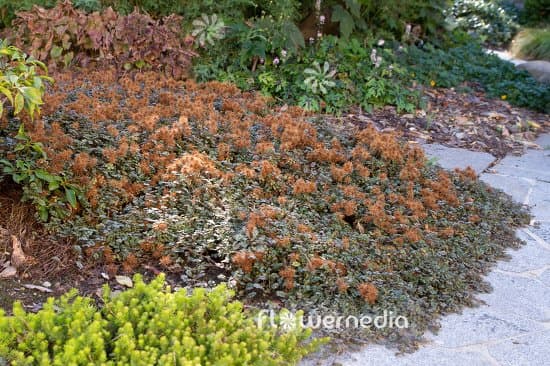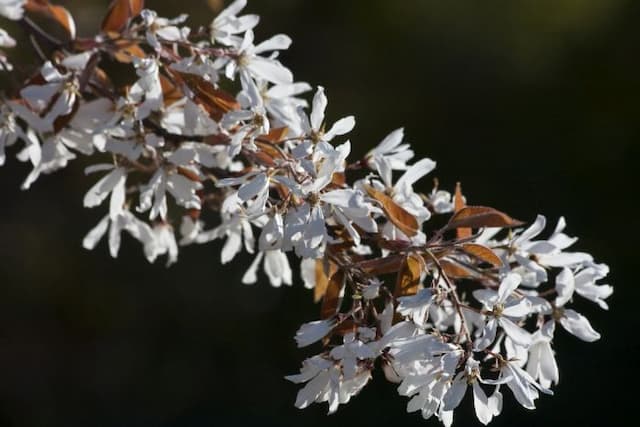Rockspray Cotoneaster Cotoneaster horizontalis

ABOUT
Cotoneaster horizontalis, commonly known as the rock cotoneaster, is a deciduous shrub characterized by its distinctive herringbone pattern of branches. The plant boasts small, glossy green leaves that adopt a stunning reddish-purple hue in the autumn before falling. Throughout the spring, the rock cotoneaster produces a profusion of pink-tinged white flowers, each small and five-petaled, creating a delicate contrast against the dense foliage. Following the blooming period, the plant is adorned with bright red berries that persist into the winter, providing a splash of color during the colder months and a food source for birds. The branching structure becomes more prominent and visually interesting when the leaves have fallen. The overall visual appeal of the rock cotoneaster lies in its intricate branch pattern, seasonal color changes, and the lovely contrast between its flowers, berries, and foliage.
About this plant
 Names
NamesFamily
Rosaceae.
Synonyms
Rockspray Cotoneaster, Rock Cotoneaster, Horizontal Cotoneaster, Wall Cotoneaster.
Common names
Cotoneaster adpressus var. horizontalis, Cotoneaster adpressus, Cotoneaster microphyllus var. horizontalis.
 Toxicity
ToxicityTo humans
Rockspray cotoneaster, or Cotoneaster horizontalis, may have some level of toxicity if ingested by humans, although it is generally considered to have a low level of toxicity. However, consuming parts of this plant can potentially cause gastrointestinal distress, leading to symptoms such as nausea, vomiting, and diarrhea. It is always best to avoid eating any part of ornamental plants due to the potential risks they may pose.
To pets
Rockspray cotoneaster, when ingested by pets such as dogs and cats, can be harmful. The level of toxicity is generally considered to be low to moderate, but consuming parts of the plant may result in gastrointestinal upset. Symptoms of poisoning in pets can include vomiting, diarrhea, and lethargy. If a pet consumes a significant quantity of the plant, it is advisable to contact a veterinarian.
 Characteristics
CharacteristicsLife cycle
Perennials
Foliage type
Deciduous
Color of leaves
Green
Flower color
Pink
Height
2-3 feet (0.6-0.9 meters)
Spread
4-6 feet (1.2-1.8 meters)
Plant type
Shrub
Hardiness zones
5
Native area
China
Benefits
 General Benefits
General Benefits- Wildlife Habitat: Cotoneaster horizontalis provides food and shelter for birds and insects.
- Ground Cover: Its dense growth habit makes it excellent for covering ground and suppressing weeds.
- Erosion Control: It can help prevent soil erosion on slopes due to its root system.
- Aesthetic Appeal: With attractive foliage and berries, it's commonly used in landscaping for decorative purposes.
- Drought Tolerance: Once established, the plant is relatively drought-tolerant, reducing the need for frequent watering.
- Low Maintenance: It requires minimal care, making it suitable for gardeners of all skill levels.
- Winter Interest: The plant retains its foliage in mild winters and the berries add color during colder months.
- Hedge and Border Planting: It can be pruned into a formal hedge or used as a border plant in gardens.
 Medical Properties
Medical PropertiesThis plant is not used for medical purposes.
 Air-purifying Qualities
Air-purifying QualitiesThis plant is not specifically known for air purifying qualities.
 Other Uses
Other Uses- Cotoneaster horizontalis, commonly known as rock cotoneaster, can be used as a soil stabilizer on slopes and banks to prevent soil erosion due to its widespread root system.
- The dense branching pattern of rock cotoneaster provides nesting sites for birds, offering shelter and protection from predators.
- The plant's ability to withstand pollution makes it suitable for urban and roadside plantings, contributing to city green spaces.
- Rock cotoneaster can be trained against a wall or fence as an espalier, creating a decorative living trellis.
- The berries of rock cotoneaster attract various kinds of wildlife, such as birds and small mammals, that feed on them.
- In miniature gardens or as part of a model landscape, this plant can be pruned to resemble miniature trees, adding an element of realism.
- Intricate branches and colorful autumn foliage can be used in floral arrangements or as part of wreaths and other seasonal decorations.
- Due to its low-growing habit, rock cotoneaster is an ideal candidate for bonsai, the Japanese art of growing miniature trees.
- When planted in a series, the plants can form a low hedge that defines the boundaries of a property without obstructing the view.
- Gardeners can use this plant's dense growth habit as a living mulch under taller shrubs or trees, suppressing weeds and maintaining soil moisture.
Interesting Facts
 Feng Shui
Feng ShuiThe Cotoneaster is not used in Feng Shui practice.
 Zodiac Sign Compitability
Zodiac Sign CompitabilityThe Cotoneaster is not used in astrology practice.
 Plant Symbolism
Plant Symbolism- Strength and Endurance: Cotoneaster horizontalis is known for its hardiness and ability to thrive in difficult conditions, symbolizing the ability to withstand adversity and remain strong.
- Grounding: As a low-growing shrub, it is often associated with being grounded and stable, providing a symbol for a solid foundation and security.
- Attractiveness: With its bright red berries and delicate flowers, this plant is often a symbol of beauty and the ability to attract positivity into one's life.
- Protection: The dense and intricate branching pattern can provide shelter for birds and other wildlife, symbolizing sanctuary and safety.
 Water
WaterFor Cotoneaster, known as Rock Cotoneaster, watering should be done thoroughly, enough to soak the root zone, when the top inch of soil feels dry to the touch. This might mean watering every week, especially during prolonged dry spells or when it's establishing. Established plants are more drought tolerant and may require less frequent watering. On average, providing about 1 to 2 gallons of water every 7 to 10 days during active growing seasons is sufficient. Over-watering or allowing the plant to sit in water can lead to root rot, so ensure good drainage.
 Light
LightRock Cotoneaster thrives best in full sun to partial shade conditions. It should be planted in a spot where it receives at least six hours of direct sunlight daily. Too much shade can lead to sparse foliage and fewer flowers and berries. The ideal spot is one that enjoys morning sunlight and some afternoon shade, especially in hotter climates to protect from intense heat.
 Temperature
TemperatureRock Cotoneaster is hardy and can tolerate a wide range of temperatures, from winter lows around -20°F to summer highs well over 90°F. For optimal growth, it prefers to be in an environment where the temperature is between 60°F and 80°F. It is well-adapted to most temperate climates but should be protected from extreme winter cold and harsh winds.
 Pruning
PruningRock Cotoneaster should be pruned to maintain shape and encourage a dense growth habit. Prune in late winter or early spring before new growth begins. Thinning out older branches every few years helps to rejuvenate the plant. Pruning can also be done right after flowering to shape the plant without sacrificing the berries, which form on the previous season's growth.
 Cleaning
CleaningAs needed
 Soil
SoilRock Cotoneaster thrives in well-draining soil with a mix of two parts loam, one part sand or perlite, and one part peat or humus. The soil pH should be slightly acidic to neutral, ranging from 6.0 to 7.5 for optimal growth.
 Repotting
RepottingRock Cotoneaster should be repotted every 2 to 3 years to prevent it from becoming root-bound and to replenish the soil's nutrients.
 Humidity & Misting
Humidity & MistingRock Cotoneaster is quite adaptable and does not require specific humidity levels; it fares well in average outdoor humidity conditions.
 Suitable locations
Suitable locationsIndoor
Ensure bright light, cool temps, and well-draining soil.
Outdoor
Plant in full sun to part shade, in well-draining soil.
Hardiness zone
5-7 USDA
 Life cycle
Life cycleCotoneaster horizontalis, commonly known as Rockspray cotoneaster, begins its life cycle with seed germination in the spring, following a period of winter stratification to break dormancy. After germination, the seedlings establish themselves with a characteristic herringbone branch pattern and start photosynthesis. As the plant grows, it enters a vegetative state where it develops woody stems, leaves, and an extensive root system. Upon reaching maturity, which can take several years, the Rockspray cotoneaster produces small pinkish or white flowers in the late spring to early summer, which are then pollinated by insects. Following pollination, the flowers develop into red pome fruits by autumn, which are eaten and dispersed by birds, thus completing the reproductive cycle. This plant can live for many years, during which it may repeatedly enter a period of dormancy in winter and resume growth and reproduction in the spring.
 Propogation
PropogationPropogation time
Spring to early summer
The most popular method of propagation for Cotoneaster horizontalis, commonly known as Rockspray Cotoneaster, is through semi-hardwood cuttings. This typically takes place in late summer. To propagate, one should select healthy, semi-hardwood stems from the current season's growth that are about 4 to 6 inches long (10 to 15 cm). The cuttings should be made just below a node, and the leaves on the lower half should be removed. The base of the cutting should be dipped in rooting hormone before being planted in a pot filled with a mix of half peat and half perlite or sand to encourage root development. The pot should be kept in a well-lit area but out of direct sunlight, and the soil should be maintained at a consistent moisture level. Roots usually develop within a few months, after which the new plants can be transplanted into individual pots or directly to their desired location in the garden.

![Tree amelanchier [Tradition]](/_next/image?url=https%3A%2F%2Fplants-admin.emdemapps.com%2Fimages%2Fplants%2F%2Fimages%2F604b56afa99a2.png&w=640&q=75)



![Strawberry [Just Add Cream]](/_next/image?url=https%3A%2F%2Fplants-admin.emdemapps.com%2Fimages%2Fplants%2F%2Fimages%2F604b5f8e7d168.png&w=640&q=75)



